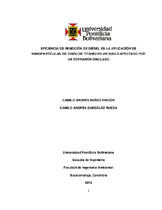Eficiencia de remoción de diésel en la aplicación de nanopartículas de óxido de titanio en un suelo afectado por un derramen simulado

Ver/
Fecha
2019-07Director/Asesor
Correa Torres, Sandra Natalia
Tipo de contenido
Trabajo de grado
Citación
Metadatos
Mostrar el registro completo del ítemDocumentos PDF
Resumen
En el desarrollo de este proyecto de grado se empleó la técnica de flushing (lavado), la cual funciona inyectando agua a presión a un suelo muestreado en una finca ubicada en Lebrija, Santander y posteriormente contaminado con diésel. El objetivo de este estudio fue determinar la eficiencia de las nanopartículas de óxido de titanio para remover diésel en un suelo afectado por un derrame simulado. Se realizaron tres fases a lo largo del proyecto para la obtención de resultados. La primera fase consistió en el análisis de las características fisicoquímicas de las NPsTiO2. En la segunda fase del proyecto se compararon las propiedades fisicoquímicas del suelo antes de la simulación del derrame, después de la simulación y después de terminar los lavados. La tercera y última fase del proyecto determinó el porcentaje de eficiencia de remoción de diésel, para lo cual se contaminaron las diferentes zonas del suelo, se agregaron las NPsTiO2 funcionalizadas previamente y a diferentes concentraciones (100,300ppm y 500ppm), se realizaron los lavados a presiones diferentes (30 y 45psi) y se realizó la prueba de TPH para obtener los resultados de remoción de diésel, los cuales alcanzaron un porcentaje de del 22.40% con una concentración de NPsTiO2 de 500ppm y una presión de lavado de 45psi. Finalmente, se realizó la prueba de absorción atómica para calcular la remoción de NPsTiO2 acumulada en el suelo al finalizar los lavados. Los resultados de esta prueba alcanzaron un valor de 7,36%. In the development of this degree project the technique of flushing (washing) was used, which works in this case by injecting water under pressure to a soil sampled farm located in Lebrija, Santander and subsequently contaminated with diesel. The objective of this study was to determine the efficiency of titanium oxide nanoparticles to remove diesel in a soil affected by a simulated spill. Three phases were carried out throughout the project to obtain results. The first phase consisted in the analysis of the physicochemical characteristics of the NPsTiO2. In the second phase of the project, the physicochemical properties of the soil were compared before the simulation of the spill, after the simulation and after the washings were finished. The third and final phase of the project determined the efficiency percentage of diesel removal, for which the different zones of the soil were contaminated, previously functionalized NPsTiO2 were added at different concentrations (100, 300ppm and 500ppm), the washes were carried out different pressures (30 and 45psi) and the TPH test was performed to obtain the results of diesel removal, which reached a percentage of 22.40% with a NPsTiO2 concentration of 500ppm and a wash pressure of 45psi. Finally, the atomic absorption test was performed to calculate the recovery of accumulated NPsTiO2 in the soil at the end of the washings. The results of this test reached a value of 7,36%.
Palabra/s clave
Nanopartículas
Oxido de titanio
Contaminación de suelos
Diesel
Síntesis
Colecciones
- Trabajos de grado [6698]
El ítem tiene asociados los siguientes ficheros de licencia:

